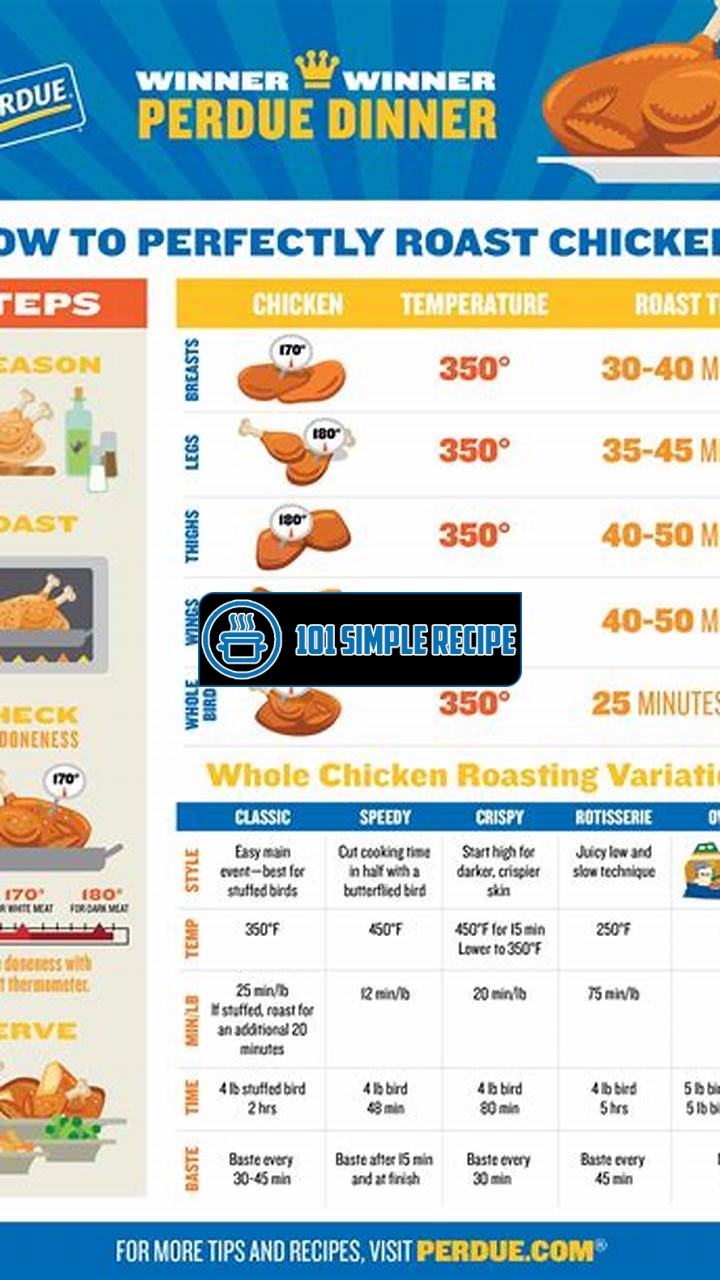If you’re tired of dry, flavorless chicken breast, then you’re in for a treat. In this article, we will show you the efficient way to cook chicken breast in the oven. By following our simple steps and tips, you’ll be able to enjoy juicy, tender chicken every time. Say goodbye to boring meals and hello to mouthwatering dishes that will impress your family and friends. So, grab your apron and let’s get cooking!

Understanding Proper Internal Temperature
When it comes to cooking chicken breast in the oven, understanding the proper internal temperature is of utmost importance. Not only does it ensure the safety of the dish, but it also plays a crucial role in achieving optimal taste and texture. By cooking the chicken breast to the correct internal temperature, you can guarantee a moist and flavorful result that will leave your taste buds satisfied.
Importance of Temperature
The internal temperature of chicken breast is critical for two main reasons – safety and taste. Firstly, cooking the chicken to the correct internal temperature is vital to eliminate any potential bacteria or pathogens that may be present. Chicken can harbor harmful bacteria like salmonella, and cooking it to the right temperature ensures that these pathogens are killed off, reducing the risk of foodborne illnesses.
Moreover, achieving the proper internal temperature is essential to ensure that your chicken breast is cooked to perfection. Overcooking chicken can result in a dry and tough texture, while undercooking it poses health risks.
Achieving Proper Internal Temperature
The USDA recommends cooking chicken breast to an internal temperature of 165°F (74°C) for safe consumption. This temperature ensures that any harmful bacteria are destroyed, making the chicken safe to eat. However, some chefs and home cooks prefer cooking the chicken to a slightly lower temperature, around 160°F (71°C), to retain more moisture and juiciness.
To accurately determine the internal temperature of your chicken breast, it is crucial to use a meat thermometer.
Using a Meat Thermometer
A meat thermometer is an indispensable tool for any home cook. By inserting the thermometer into the thickest part of the chicken breast, you can obtain an accurate reading of its internal temperature. Be sure to avoid touching the bone or hitting the pan, as it may affect the accuracy of the reading.
It is essential to follow the manufacturer’s instructions for your specific meat thermometer, as different models may have varying features and temperature ranges. Once you have inserted the thermometer, wait for a few seconds until the reading stabilizes. If the temperature has reached 165°F (74°C) or above, your chicken breast is safe to consume.
Remember to clean your meat thermometer thoroughly after each use to prevent cross-contamination.
Cooking chicken breast to the correct internal temperature is crucial for both safety and taste reasons. By understanding the significance of internal temperature, achieving the proper temperature, and using a meat thermometer, you can ensure a delicious and safe dining experience. So, the next time you cook chicken breast in the oven, make sure to keep an eye on that temperature!
The Role of Seasonings
Seasonings play a crucial role in enhancing the flavor of your oven-baked chicken breast. They have the power to transform a plain and bland piece of meat into a mouthwatering dish that will leave you wanting more. By carefully selecting and applying the right seasonings, you can take your chicken breast to a whole new level of deliciousness. Let’s explore the impact of seasonings and discover how they can elevate your culinary experience.
Benefits of Seasonings
Seasonings offer numerous benefits when it comes to cooking chicken breast in the oven. First and foremost, they enhance the taste of the meat by adding layers of flavors. Whether you prefer a savory, spicy, or tangy profile, seasonings allow you to customize the taste according to your liking. Additionally, they help to tenderize the chicken breast, making it juicier and more tender when cooked.
Another advantage of using seasonings is their ability to add visual appeal to your dish. With the right combination of herbs and spices, you can create a visually enticing chicken breast that looks as good as it tastes. This is especially important when serving guests or posting pictures of your culinary creations on social media.
Popular Seasoning Options
When it comes to seasoning chicken breast, the options are endless. Here are some popular seasoning choices that are sure to elevate your oven-baked chicken breast:
- Classic Herbs: Utilize traditional herbs such as thyme, rosemary, and sage to infuse your chicken breast with a rich and earthy flavor.
- Spice Blends: Experiment with spice blends like cajun, jerk, or curry to give your chicken breast a kick of heat and a burst of exotic flavors.
- Citrus Zest: Brighten up your dish with the tangy zest of citrus fruits like lemon, lime, or orange. This adds a refreshing and tangy element to your chicken breast.
- Garlic and Onion: Enhance the savory profile of your chicken breast by incorporating garlic and onion powder. These aromatics provide a robust and comforting flavor.
Applying Seasonings to Chicken Breast
Now that you have a variety of seasonings to choose from, it’s time to explore how to apply them to your chicken breast. The most effective way is to create a seasoning blend by mixing your chosen herbs and spices together. You can also create a marinade by combining the seasonings with oil, vinegar, or yogurt, which not only adds flavor but also helps tenderize the meat.
Once you have your seasoning blend or marinade ready, generously coat both sides of the chicken breast with it. Massage the seasoning into the meat, ensuring that every inch is properly covered. For even more intense flavor, let the chicken breast marinate in the refrigerator for a few hours or overnight.
When it’s time to cook the chicken breast, preheat the oven to the recommended temperature and place the seasoned chicken on a baking sheet or in a baking dish. Cook the chicken breast until the internal temperature reaches the desired level of doneness, using a meat thermometer for accuracy.
Remember, cooking times may vary depending on the size and thickness of the chicken breast, so it’s essential to monitor the temperature to avoid undercooking or overcooking.
In conclusion, seasonings play a vital role in enhancing the flavor of your oven-baked chicken breast. They offer a multitude of benefits, such as adding taste, tenderizing the meat, and improving the visual appeal of the dish. By experimenting with different seasoning options and applying them correctly, you can create a chicken breast that is bursting with flavor and sure to impress your taste buds. So go ahead, get creative with your seasonings, and take your chicken breast to new culinary heights!
Preparation and Marination
When it comes to cooking chicken breast in the oven, proper preparation and marination are essential steps to ensure a delicious and tender result. By following a few simple techniques, you can elevate the taste and tenderness of your chicken breast to a whole new level.
Cleaning and Trimming Chicken Breast
First and foremost, it’s important to start with clean chicken breast. Rinse the chicken breasts under cold water to remove any excess blood or impurities. Pat them dry with paper towels to ensure a crispy skin and prevent any liquid from diluting the flavors as it cooks.
Next, it’s time to trim the chicken breast. Using a sharp knife, carefully remove any excess fat or connective tissue from the chicken breasts. This not only improves the overall texture of the meat but also allows the marinade to penetrate more effectively.
Marinating Techniques and Timing
Marinating is a crucial step in enhancing the flavor and tenderness of your chicken breast. There are several marinating techniques to consider:
- Basic marinade: Create a simple marinade using ingredients like olive oil, lemon juice, garlic, salt, and pepper. Let the chicken breast sit in the marinade for at least 30 minutes to overnight in the refrigerator. This allows the flavors to penetrate the meat and tenderize it.
- Acidic marinade: Incorporate acidic ingredients like vinegar, citrus juice, or yogurt into your marinade. The acid helps break down the proteins in the chicken, resulting in a more tender and flavorful end result. Aim for a marinating time of 1 to 2 hours.
- Brining: Brining involves soaking the chicken breast in a solution of salt and water. This process helps the meat retain moisture during cooking, resulting in a juicier final product. Brine the chicken for at least 2 hours, but no more than 6 hours, depending on its size.
Remember to always marinate your chicken in the refrigerator to prevent the growth of harmful bacteria.
Avoiding Common Marinating Mistakes
While marinating can greatly enhance the flavor and tenderness of your chicken breast, it’s important to avoid common mistakes that can impact the outcome.
One mistake to avoid is over-marinating. Leaving the chicken breast in the marinade for too long can result in the meat becoming mushy or overly salty. Follow the recommended marinating times for the best results.
Another mistake is under-marinating. Allowing insufficient time for the flavors to permeate the chicken can lead to a bland taste. Be patient and give the marinade enough time to work its magic.
Lastly, refrain from reusing marinade that has come into contact with raw chicken. The marinade may contain harmful bacteria from the raw meat, so it’s better to discard it and make a fresh batch if you need extra for basting or serving.
By following these guidelines for cleaning, trimming, marinating, and avoiding common mistakes, you can ensure that your chicken breast cooked in the oven will be flavorful, tender, and absolutely delicious. Happy cooking!
Oven Selection and Preheating
When it comes to cooking chicken breast in the oven, the efficiency of the cooking process greatly depends on the oven you choose and how you preheat it. In this section, we will delve into the importance of selecting the right oven and preheating it correctly for optimal chicken breast cooking results.
Selecting the Right Oven
The first step in achieving perfect results for your chicken breast is selecting the right oven. There are various types of ovens available on the market, and each has its own features and capabilities. When choosing an oven, consider the following factors:
- Size and Capacity: Ensure that the oven is large enough to accommodate your chicken breast without overcrowding. This will ensure even cooking and prevent any undercooked or overcooked portions.
- Temperature Control: Look for an oven that provides precise temperature control. This will allow you to set the desired temperature accurately, ensuring that your chicken breast is cooked to perfection.
- Convection Feature: Consider opting for an oven with a convection feature. Convection ovens use a fan to circulate hot air evenly throughout the oven, resulting in faster and more even cooking.
- Energy Efficiency: Choose an oven that is energy-efficient to minimize electricity consumption and save on your energy bills in the long run.
By carefully considering these factors, you can select an oven that is perfectly suited for cooking chicken breast and will deliver optimal results every time.
Preheating the Oven Correctly
Another crucial step in ensuring efficient cooking of chicken breast in the oven is preheating it correctly. Preheating is the process of heating the oven to the desired temperature before placing the chicken breast inside. Here are some important steps to follow for proper preheating:
- Check Thermostat Accuracy: Before preheating, it’s essential to ensure that your oven’s thermostat is accurate. Use an oven thermometer to verify the temperature and adjust if necessary.
- Remove Oven Racks: Take out any oven racks or baking sheets that may obstruct the airflow inside the oven. This will allow the hot air to circulate freely and ensure even cooking.
- Set the Temperature: Set the oven to the appropriate temperature for cooking chicken breast. The recommended temperature is usually around 375 to 400 degrees Fahrenheit (190 to 200 degrees Celsius), but it may vary depending on the recipe.
- Allow Sufficient Preheating Time: Give the oven enough time to reach the desired temperature. This typically takes around 10 to 15 minutes, depending on the oven model and size.
By following these preheating steps, you can create the ideal cooking environment for your chicken breast and ensure that it cooks evenly and thoroughly.
Benefits of Preheating
Preheating the oven has several benefits when it comes to cooking chicken breast:
Even Cooking: Preheating allows for even distribution of heat throughout the oven, ensuring that your chicken breast cooks evenly from all sides. This eliminates any overcooked or undercooked spots.
️ Accurate Temperature: Preheating helps to achieve and maintain the desired cooking temperature. This is crucial for ensuring that the chicken breast is cooked to the perfect internal temperature and remains juicy and flavorful.
⏳ Saves Time: Preheating reduces the overall cooking time by eliminating the need for the chicken breast to heat up along with the oven. This ensures that your chicken breast cooks in a timely manner without any unnecessary delays.
In conclusion, selecting the right oven and preheating it correctly are essential steps for cooking chicken breast in the oven efficiently. By choosing an oven that suits your needs and following the proper preheating techniques, you can achieve perfectly cooked chicken breast every time. So, make sure to pay attention to these details and enjoy your deliciously cooked chicken breast!
Monitoring Cooking Time
When it comes to cooking chicken breast in the oven, monitoring the cooking time is of utmost importance. This simple step ensures that your chicken breast is neither undercooked nor overcooked, resulting in a perfectly tender and juicy meal. By understanding the significance of monitoring the cooking time, you can elevate your cooking skills and create delicious chicken dishes every time.
One of the main reasons why monitoring the cooking time is crucial is to avoid undercooked chicken breast. Undercooked chicken can pose significant health risks as it may contain harmful bacteria such as Salmonella or Campylobacter. These bacteria can cause food poisoning and lead to unpleasant symptoms like nausea, vomiting, and diarrhea. By monitoring the cooking time, you can ensure that the internal temperature of the chicken breast reaches a safe level, killing any potential bacteria.
On the other hand, overcooked chicken breast can result in dry, tough, and flavorless meat. Overcooking occurs when the chicken breast is exposed to high temperatures for an extended period, causing it to lose moisture and become rubbery. By monitoring the cooking time, you can prevent this from happening and achieve a perfectly cooked chicken breast with a delightful texture and taste.
Recommended Cooking Time:
To determine the recommended cooking time for chicken breast in the oven, it is essential to consider its size and thickness. A general rule of thumb is to cook boneless, skinless chicken breasts at 350°F (175°C) for approximately 20 to 25 minutes. However, cooking times may vary slightly depending on the oven’s accuracy and the size of the chicken breast.
Using a Timer or Alarm:
Using a timer or alarm can be incredibly helpful in monitoring the cooking time. Set the timer based on the recommended cooking time and make sure it is easily visible and audible from your cooking area. This way, you can focus on other tasks while ensuring that you don’t forget to check the chicken breast.
Checking for Doneness:
Once the timer goes off, it’s crucial to check the doneness of the chicken breast before removing it from the oven. To do this, insert an instant-read meat thermometer into the thickest part of the chicken breast. The internal temperature should read 165°F (74°C) to ensure that it is fully cooked. If the temperature is lower, return the chicken breast to the oven for a few more minutes until it reaches the desired temperature.
In conclusion, monitoring the cooking time is an essential step in cooking chicken breast in the oven. By understanding the significance of this process, following the recommended cooking time, using a timer or alarm, and checking for doneness, you can achieve perfectly cooked chicken breast every time. So, next time you cook chicken breast in the oven, remember to keep an eye on the clock and ensure a delicious and safe meal for you and your loved ones.
Thank you for taking the time to read our article on how to cook chicken breast in the oven. We hope you found the information helpful and that it will inspire you to try this delicious and healthy cooking method. Remember, cooking times may vary depending on the thickness of the chicken breasts, so always use a reliable meat thermometer to ensure they are cooked through. If you enjoyed this article, be sure to bookmark our website and visit us again for more cooking tips and recipes. Happy cooking!
Frequently Asked Questions
Here are some common questions about cooking chicken breast in the oven:
| No. | Questions | Answers |
|---|---|---|
| 1. | What temperature should I cook chicken breast in the oven? | Chicken breast should be cooked in the oven at 350°F (175°C) for about 25-30 minutes. Use a meat thermometer to ensure it reaches an internal temperature of 165°F (74°C) for safe consumption. |
| 2. | Should I cover the chicken breast while baking in the oven? | It is not necessary to cover the chicken breast while baking in the oven. Leaving it uncovered will allow the chicken to brown and develop a crispy exterior. |
| 3. | How do I know when the chicken breast is done? | The chicken breast is done when it reaches an internal temperature of 165°F (74°C). Use a meat thermometer inserted into the thickest part of the breast to check the temperature. |
| 4. | Can I marinate the chicken breast before baking? | Yes, marinating the chicken breast before baking can infuse it with flavor. It is recommended to marinate for at least 30 minutes or up to 24 hours in the refrigerator. |
| 5. | What other seasonings can I use to flavor the chicken breast? | You can use a variety of seasonings to flavor the chicken breast, such as garlic powder, paprika, Italian seasoning, or lemon pepper. Experiment with your favorite flavors to find the ones you enjoy the most. |
| 6. | Can I use bone-in chicken breasts instead of boneless? | Yes, you can use bone-in chicken breasts for oven cooking. The cooking time may need to be adjusted slightly, as bone-in chicken generally takes longer to cook than boneless. |
Closing Thoughts
We hope this article has given you the confidence to cook delicious chicken breast in the oven. Remember to follow the recommended cooking temperature and use a meat thermometer to ensure perfect doneness. Whether you’re cooking for yourself, your family, or entertaining guests, oven-roasted chicken breast is a versatile and healthy option. Don’t be afraid to experiment with different seasonings and marinades to create your own signature dish. Thank you for reading, and we look forward to sharing more culinary adventures with you in the future. Happy cooking!
Jump to Recipe
Temp to Cook Chicken Breast in Oven

Learn the perfect temperature and cooking time for chicken breast in the oven to achieve juicy and flavorful results every time.
- 4 boneless (skinless chicken breasts)
- 1 teaspoon salt
- 1/2 teaspoon black pepper
- 1/2 teaspoon garlic powder
- 1/2 teaspoon paprika
- 1 tablespoon olive oil
- Preheat the oven to 350°F (175°C).
- In a small bowl, combine the salt, black pepper, garlic powder, and paprika. Rub the mixture onto both sides of the chicken breasts.
- Heat olive oil in a large oven-safe skillet over medium-high heat. Add the chicken breasts and cook for 2 minutes per side, until browned. Transfer the skillet to the preheated oven and bake for 25-30 minutes, or until the chicken reaches an internal temperature of 165°F (74°C).
- Remove the skillet from the oven and let the chicken rest for a few minutes before serving. Enjoy!



